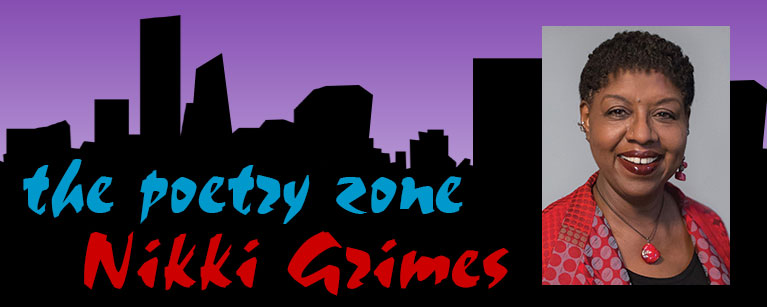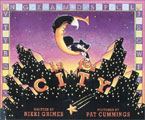Growing up, it troubled me that the books to be found about black people concerned either slavery or the Civil Rights Movement, and preciously little else. As for books about contemporary life, forget it. It was as if African Americans simply did not exist within that framework. So, as an author, I determined early on to focus on African American children navigating the ups and downs of contemporary life. I wanted to create stories with which today’s young black readers could relate. In doing so, I sought, and continue to seek, to give voice to the voiceless.
That said, my books are not only relatable to black readers. The stories I tell are human stories, stories of loss, forgiveness and grace, stories that are sometimes humorous, sometimes tragic. My characters laugh and cry, bleed red when cut, wrestle with rage, remorse, confusion, and all the other emotions human beings experience. In other words, despite the specificity of race, my stories, whether in poetry or prose, are for everyone.
Recently, I visited two of the largest independent booksellers in a major metropolitan area. In the first, the store’s owner and two of her employees expressed how honored they were to meet me. They each rattled off some of their favorites of titles authored by me, spoke glowingly about sharing my books with their young charges, in schools and libraries where they’d worked in the past, and even posed for photographs with me. Clearly, they had enormous respect for the work I do. And yet,they had only one copy of one of my books on their shelves—and the most commercial one, at that. As for the second store, they had not a single title—this in a season in which I had two new books, and one reissue shipping to stores across the country.
Huh? I don’t get it.
I left both stores shaking my head, but it didn’t take me long to connect the dots. Each store was located in a predominantly white neighborhood.
Now, before you say “Oh! That makes sense,” keep in mind that my readership crosses all boundaries of race and culture. I get letters from black and Hispanic readers, as you would no doubt assume. There are also fans as far away as China and Japan. But I also get at least half my letters from white readers on farms in the Midwest, mining communities in Appalachia, schools in the south, and points throughout the Pacific Northwest, among others. In other words, white children are reading and loving my books. So, the children are not the problem.
Once again, the problem is with the gatekeepers—in this case, the booksellers. It is they who assume that their customers will not be interested in the books I write. Why? Because the characters on the cover are African American. But those booksellers are wrong. I frequently hear from white parents who are frustrated in their attempts to build racially diverse book collections for their children, wanting to expose their young ones to all of the cultures that make up this great country. They go to their local bookstores on the hunt and are dismayed by the lack of multicultural and, specifically, black titles available on the shelves.
Some well-meaning white friends sometimes try to shush me when I bring up race, especially as it pertains to the children’s book field, but the hard truth is that race remains a sticky wicket in this country, a black man in the Oval Office notwithstanding.
I’ve spent many long years trying to write my way out of the ghetto. I’ve published prodigiously, promoted my work through bookstore events, regularly spoken at conferences and book festivals, crisscrossed the country visiting schools, given countless interviews, written features and editorials for numerous trade journals and more. I’ve even garnered a fair share of prestigious book awards. But for all that, I find that my work is still being marginalized. I’ve lost count of the number of bookstore shelves absent of my books, even in those years when I’ve published as many as five titles. Sigh.
Here’s what I’ve come to: I can’t control booksellers, or other gatekeepers, or their reasons for choosing not to stock, at the very least, my most current titles. The only thing I can control is my work. So I will continue to write books that matter, for children and young adults who matter, whether they operate in the margins or not. I still hold out hope that my work will somehow continue to reach the broadest possible audience.
I hope book-lovers in every community begin to demand a more racially diverse selection of titles from which to choose. In the end, that’s not on me. I get that now.




9 Responses
You’re speaking the truth in love. Thank you.
Yes, keep writing your books! We need them. And, don’t give up hope. There are more and more of us (well-known and less well-known) who are speaking up about this issue. We need to have your books available, even if that means searching a little harder for them right now.
I’ll link to this post from my blog.
http://michellecusolito.blogspot.com/
Well said!
Yes She Is. Nothing But Lovee Hunny . !
About how to get booksellers to put your book on the shelf where we’d all like to read it:
1. Now is the age of abstract cover design. White words on black background. But I know I’ve heard many people speak about the importance of seeing an African American on the cover for African American readers, so that won’t fix it.
2. I’ve seen people put purple, blue, and green people on the front cover to infer pigment, but also imply a sort of interior hue that is the same in all people instead of skin color. But I think that day is long over. Why be so suggestive when you can now say what you mean?
3. Maybe a cover with people of more than one color on the front? Maybe a set of your books, spine out, inside a nice box covered in symbols, objects or images that are the universal things you love to speak about. Maybe it’s really about aesthetic prejudice in art and less about prejudice against people and good stories. A cover with one character with dark skin on the cover with a pale background screams out, this is about pigment, or this is about my interior life and not about you.
A cover with a very pale skinned person on a black background screams out that they are very vulnerable like certain Vampire books.
A cover with a pale person on a pale background looks dreamy and introspective.
A cover with a dark skinned person on a dark background looks mysterious.
It’s sometimes about color theory in the artist’s sense. A less realistic painting of a person, no matter their color, can have all sorts of colors and textures that imply all kinds of things and may be more inviting. Look at Van Gough and others.
Or tell the publisher to wrap them in brown paper. Everyone will have to buy them and stock them because everyone loves a good mystery right?
Thanks for your blog
I hope the book sellers restock better,
Polly McCann
Hamline U.
Nikki,
Hear! Hear! and Amen!
Occasionally, African American authors and illustrators are not preaching to the choir. Others do hear you. And we agree with Mitali. “You’re speaking the truth in love.”
Thank you,
Cheryl and Wade Hudson
Just Us Books, Inc.
Amen .
Greetings from Harlem!
We are a class of 3rd graders in a public school on 127th street in Harlem. We are a diverse group of individuals; in race, personality, learning styles and beliefs. We are from Puerto Rico, Dominican Republic, Africa, islands in the Carribean, Yemen and Europe. Although our life experiences have taught us different perspectives, we all can relate to each other through understanding emotions. This is also how we connect to your books. No matter where you are from, how much money you have or what your skin color is, we have all felt fear, anxiety, love, desperation, happiness and tragedy. Right now we are reading “Jazmin’s Notebook,” which takes place right around the corner from our school. We look out on the world from Jazmin’s stoop and connect to her through our own experiences. We have read “Meet Danitra Brown” and love the way she loves herself. We are continuing to learn about you and why you write. We are reading lots of your books. Thank you for creating characters that we can relate to and learn from. Please keep writing so we can continue to learn about our world and ourselves through your characters!
Whenever I see book authored by people of color, I turn them face out even though as soon as a clerk sees them, I know they’ll go back to their hidden space. Small gesture, but maybe for those few minutes, they will capture a reader’s attention and wallet.